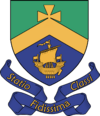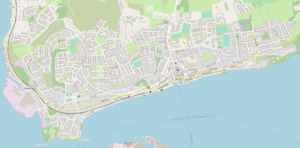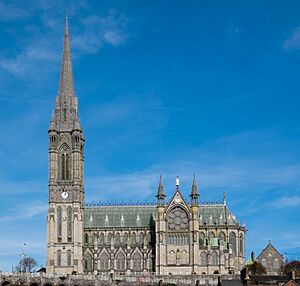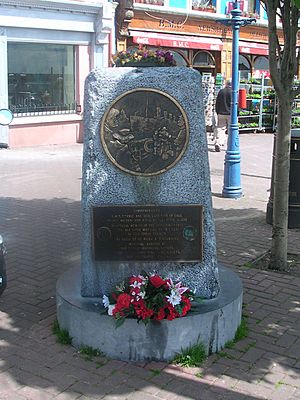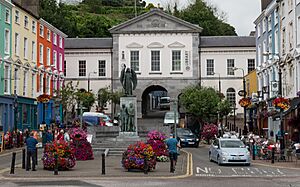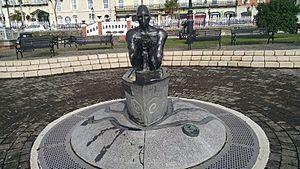Cobh facts for kids
Quick facts for kids
Cobh
An Cóbh
|
||
|---|---|---|
|
Town
|
||
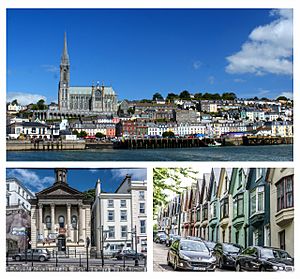
Clockwise from top: Cobh and St Colman's Cathedral as seen from Cobh Harbour; a row of Victorian houses known locally as the "deck of cards"; and the neoclassical former Methodist Church
|
||
|
||
| Motto(s): | ||
| Country | Ireland | |
| Province | Munster | |
| County | County Cork | |
| Dáil Éireann | Cork East | |
| Area | ||
| • Urban | 5.1 km2 (2.0 sq mi) | |
| Elevation | 47 m (154 ft) | |
| Population
(2022)
|
||
| • Town | 14,148 | |
| • Density | 2,774.1/km2 (7,185/sq mi) | |
| Time zone | UTC±0 (WET) | |
| • Summer (DST) | UTC+1 (IST) | |
| Eircode routing key |
P24
|
|
| Telephone area code | +353(0)21 | |
| Irish Grid Reference | W793666 | |
Cobh (pronounced KOHV) is a busy port town on the south coast of County Cork, Ireland. From 1849 to 1920, it was known as Queenstown. In 2022, about 14,148 people lived there.
Cobh is located on the south side of Great Island in Cork Harbour. It is home to Ireland's only special terminal for large cruise ships. Many visitors come to Cobh to learn about its rich history of sea travel and emigration.
Across from the town are Spike Island and Haulbowline Island. High up in the town, you can see St Colman's Cathedral. This church is one of the tallest buildings in Ireland, standing 91.4 metres (300 feet) tall.
Contents
What's in a Name? Cobh's Changing Identity
The village on Great Island was once called "Ballyvoloon." This name came from the Irish words for "O'Malone's town." The port, built by the Royal Navy in the 1750s, was known as "The Cove of Cork" or simply "Cove."
In 1849, Queen Victoria visited the area. The town was then renamed "Queenstown" in her honour. This name lasted until 1920, during the Irish War of Independence. The local council voted to change the name to Cobh. Cobh is an Irish spelling of the English word "Cove." It sounds the same as "Cove" but does not have a meaning in the Irish language itself.
Long ago, the area was called Cuan an Neimheadh, which means "the Harbour of Neimheidh." Nemed was a figure from old Irish legends. Great Island was known as Oileán Ard Neimheidh, meaning "the high island of Neimheidh."
Cobh's Fascinating History
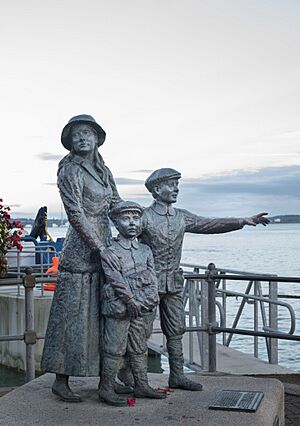
Cobh has a long and interesting past, from ancient legends to major world events.
Early Days and Settlements
Legend says that Neimheidh, one of Ireland's first settlers, landed in Cork Harbour over 1,000 years BC. He and his followers were said to have died from a plague. But Great Island was named Oilean Ard Neimheadh because of him. Later, the powerful Uí Liatháin kingdom ruled the area. The island then became known as Oilean Mor An Barra after the Barry family.
The village was known as Ballyvoloon, looking over "The Cove." In 1743, a fort, later called Cove Fort, was built east of the village. By 1750, the settlement was called Cove village. It was home to sailors and tax officials.
The Royal Cork Yacht Club (RCYC) started nearby in 1720. It is the oldest yacht club in the world. The RCYC was based in Cobh for many years. The Sirius Arts Centre building used to be one of their clubhouses.
Cobh in the 1800s: A Growing Port
In the early 1800s, Cobh grew quickly. Its naturally protected harbour made it a key naval base, especially during the Napoleonic Wars. Many of the buildings you see today were built around this time. The Irish Naval Service headquarters is now on Haulbowline Island, facing Cobh.
After the wars ended, Cobh became known as a health resort. People came here for the mild climate. The poet Charles Wolfe, who wrote "The Burial of Sir John Moore," is buried in the Old Church Cemetery outside the town.
The Titanic: Cobh's Famous Connection
Cobh was a major port for people leaving Ireland to go to North America. Between 1848 and 1950, 2.5 million Irish people sailed from here.
On April 11, 1912, when it was still called Queenstown, Cobh was the last stop for the Titanic. This famous ship was on its first trip across the Atlantic. Two smaller ships, the P.S. America and the P.S. Ireland, helped passengers and luggage get to the Titanic.
123 passengers boarded the Titanic in Cobh. Sadly, only 44 of them survived when the ship sank.
Leaving Ireland: Penal Transportation
Cobh was also a main port for people sent to penal colonies like Australia. These were places where people who had committed crimes were sent as punishment. The Scots Church, now the Cobh Museum, has records of these journeys. It overlooks the harbour where so many people departed.
Building Ships in Cobh
Shipbuilding was an important industry in Cobh. The old Verolme Shipyard still has many of its original cranes. These show the town's history in building ships.
Cobh is linked to several steamship firsts. In 1821, the first steamship sailed from Ireland to England from here. In 1838, the Sirius was the first steamship to cross the Atlantic, sailing from Passage West.
The Lusitania and World War I
Another famous ship, the RMS Lusitania, was sunk by a German U-boat near the Old Head of Kinsale on May 7, 1915. This happened while it was sailing from the US to Liverpool. 1,198 passengers died, but 700 were rescued. Survivors and the dead were brought to Queenstown (Cobh). Over 100 people who died are buried in the Old Church Cemetery. The Lusitania Peace Memorial is in Casement Square.
During the First World War, Queenstown was a naval base for British and American ships. These ships fought against German U-boats that were attacking Allied merchant ships. Q-ships, which were armed merchant ships designed to trick submarines, were often fitted out in Queenstown.
American destroyers arrived in May 1917. Their sailors were the first American servicemen to fight in the war. The town welcomed them, grateful for their help against the U-boats. The United States Navy also set up a naval air station in Queenstown in 1918. It used flying boats during the war.
After 1922, under the 1921 Anglo-Irish Treaty, Cobh remained a British naval base. It was one of the Treaty Ports. In 1938, it was finally handed over to the Irish Free State government.
Cobh Today: Economy and Tourism
Tourism is a big part of Cobh's economy. Many large cruise ships visit Cobh every year, mostly in summer. Almost 100,000 cruise passengers and crew arrive in the town each year. Their ships dock right in the town centre.
Tourist attractions focus on Cobh's sea and emigration history. These include the Queenstown Story at the Cobh Heritage Centre, the Titanic Experience, and walking tours. You can also visit the Cobh Museum and St Colman's Cathedral. The town still looks much the same as it did when the Titanic left in 1912.
Spike Island and Haulbowline Island face the town. Haulbowline Island is now the main base for the Irish Naval Service.
Cobh used to have Ireland's only steelworks, called Irish Steel. It closed in 2001. Another important employer was the Verolme Cork Dockyard. It opened in 1960 but closed in the mid-1980s. Ship repair work still happens at Rushbrooke.
In recent years, new developments have been built. These include a retail park in 2008 and a leisure centre with a swimming pool in 2007. Tours of Spike Island started in 2010.
Getting Around Cobh
Train Travel
Cobh is one of the few towns in Ireland with a commuter train service outside of Dublin. It is one of two end points for Cork Commuter Services. Regular trains run between Cork city and Cobh. The journey to Cork takes less than 25 minutes.
Cobh railway station first opened in 1862 as Queenstown station. It was renamed Cobh around 1925.
Air Travel
The closest airport is Cork Airport. You can reach it in 20–30 minutes from Cobh by car.
Port Operations
The main office for Cork Harbour's port operations is in Cobh. The boats that guide ships into the harbour are based at the Camber, a pier area at the east end of town.
Roads and Ferry
Currently, only one road (the R624) and a road bridge lead onto Great Island. This bridge, Belvelly Bridge, was built in 1803.
In 1993, a Cross River Ferry started operating. It takes cars and passengers from Glenbrook to Carrigaloe on Great Island. The trip takes four minutes and runs daily.
Arts, Culture, and Fun in Cobh
The Sirius Arts Centre is a main place for arts in Cobh. It is on the waterfront and hosts cultural events and music concerts.
The Cobh Peoples Regatta happens every August. It features local musicians and a pageant to choose the 'Regatta Queen'. The festival usually ends with fireworks over the harbour.
Cobh was a filming location for the 2009 movie The Eclipse and the 1999 movie Angela's Ashes.
Learning in Cobh
Cobh has several schools. These include Colaiste Muire secondary school and Carrignafoy Community College. Scoil Iosaef Naofa is a boys' primary school.
Sports and Activities
Cobh GAA is the local GAA club. They have a centre for gaelic games at Carrignafoy.
Cobh Pirates RFC is the town's rugby union club. They play their home games at 'The Paddocks'. The Cobh Pirates Ladies team started around 2010.
The most well-known football team is Cobh Ramblers. Famous players like Roy Keane and Stephen Ireland started their careers here. Cobh Ramblers play in the League of Ireland First Division.
Cobh Golf Club has an 18-hole course at Marino. Rushbrooke Lawn Tennis & Croquet Club, founded in 1870, is one of Ireland's oldest tennis clubs.
There are two coastal rowing clubs: Cobh Fishermen and Rushbrooke Rowing Club. The "Escape from Spike Island" triathlon is held every year in late summer.
Cobh also has two Scouting Ireland groups, one of which is a Sea Scout group.
Famous People from Cobh
Many notable people have connections to Cobh:
- Anne Elizabeth Ball (1808–1872) and Mary Ball (1812–1898), sisters and scientists who studied seaweeds.
- Robert Ball (1802–1857), brother of Anne and Mary Ball, a zoologist.
- Decimus Burton (1800–1881), an English architect who designed many of Cobh's streets.
- Nellie Cashman (1845–1925), a gold prospector and helper of others, born near Cobh.
- Jack Doyle (1913–1978), a boxer, actor, and singer.
- Stephen Ireland, a former Manchester City and Republic of Ireland international footballer.
- Roy Keane, a former Manchester United footballer, who started his career with Cobh Ramblers.
- Sonia O'Sullivan, who won a silver medal in the 5000 m race at the 2000 Sydney Olympic Games.
- Fiona Shaw, a well-known actress, born in Cobh in 1958.
Sister Cities
Cobh has special connections with other towns around the world:
- Kolbuszowa, Poland
- Ploërmel, France
- Lake Charles, Louisiana, US
- Pontarddulais, Wales
Images for kids
See also
 In Spanish: Cobh para niños
In Spanish: Cobh para niños


